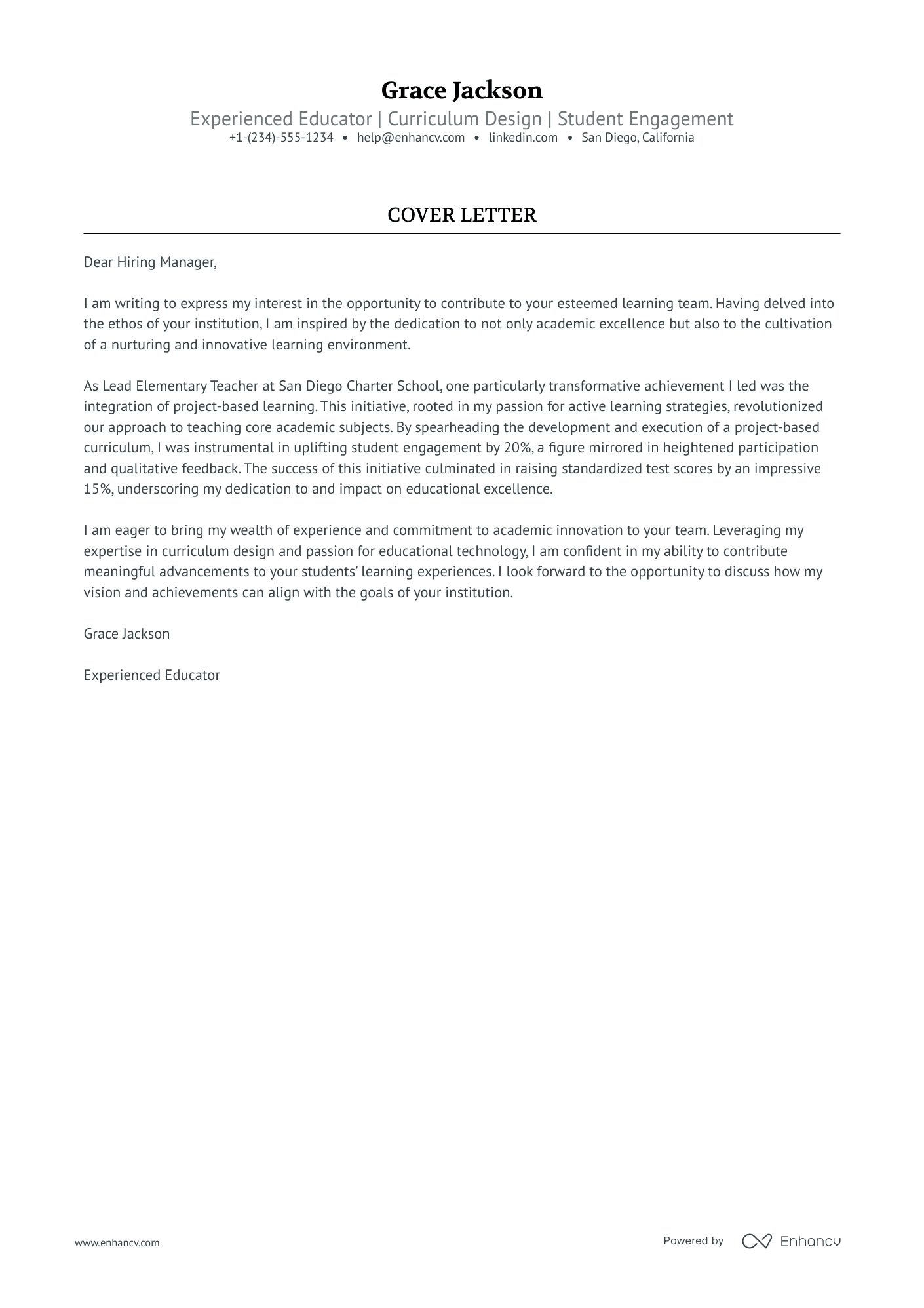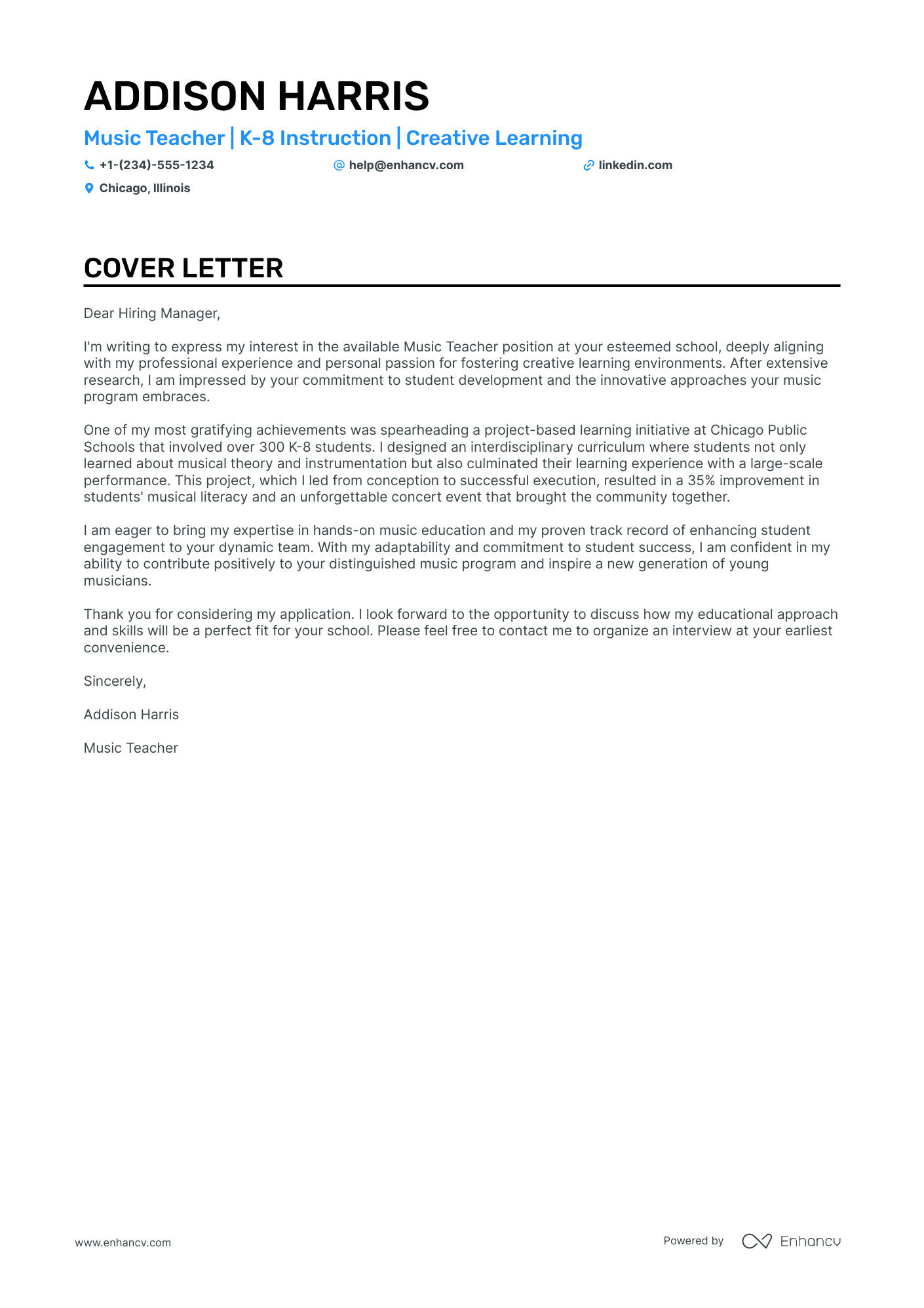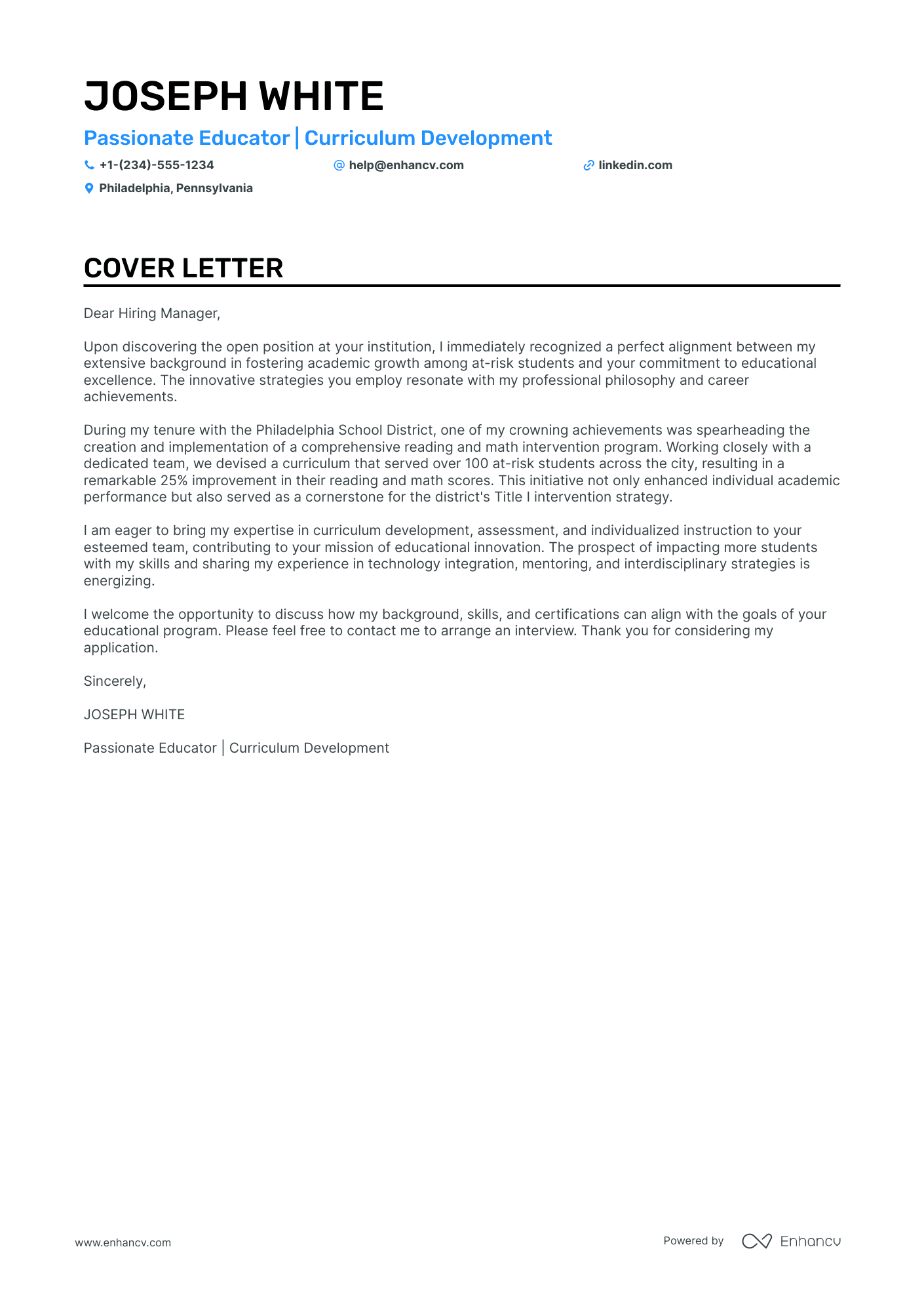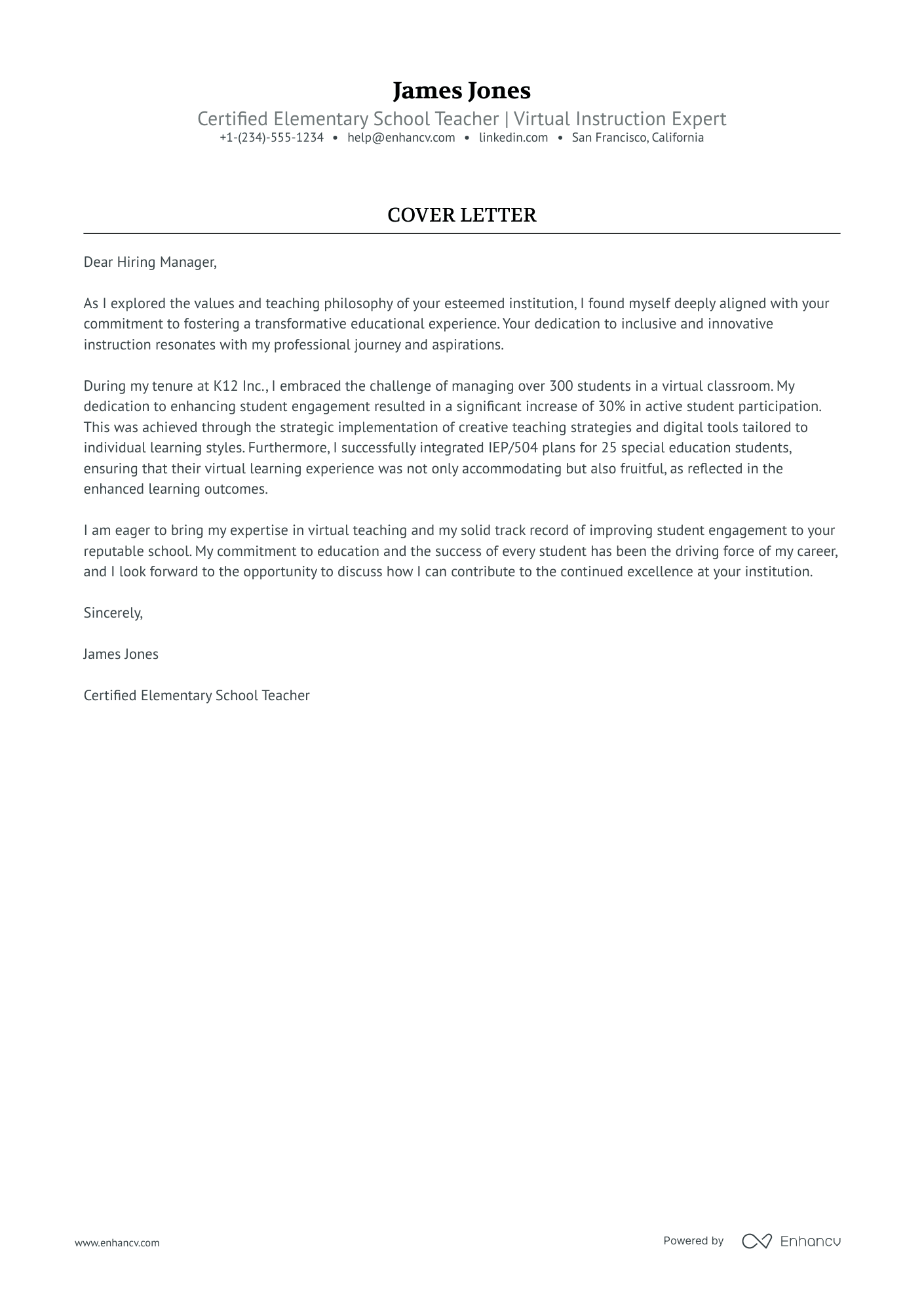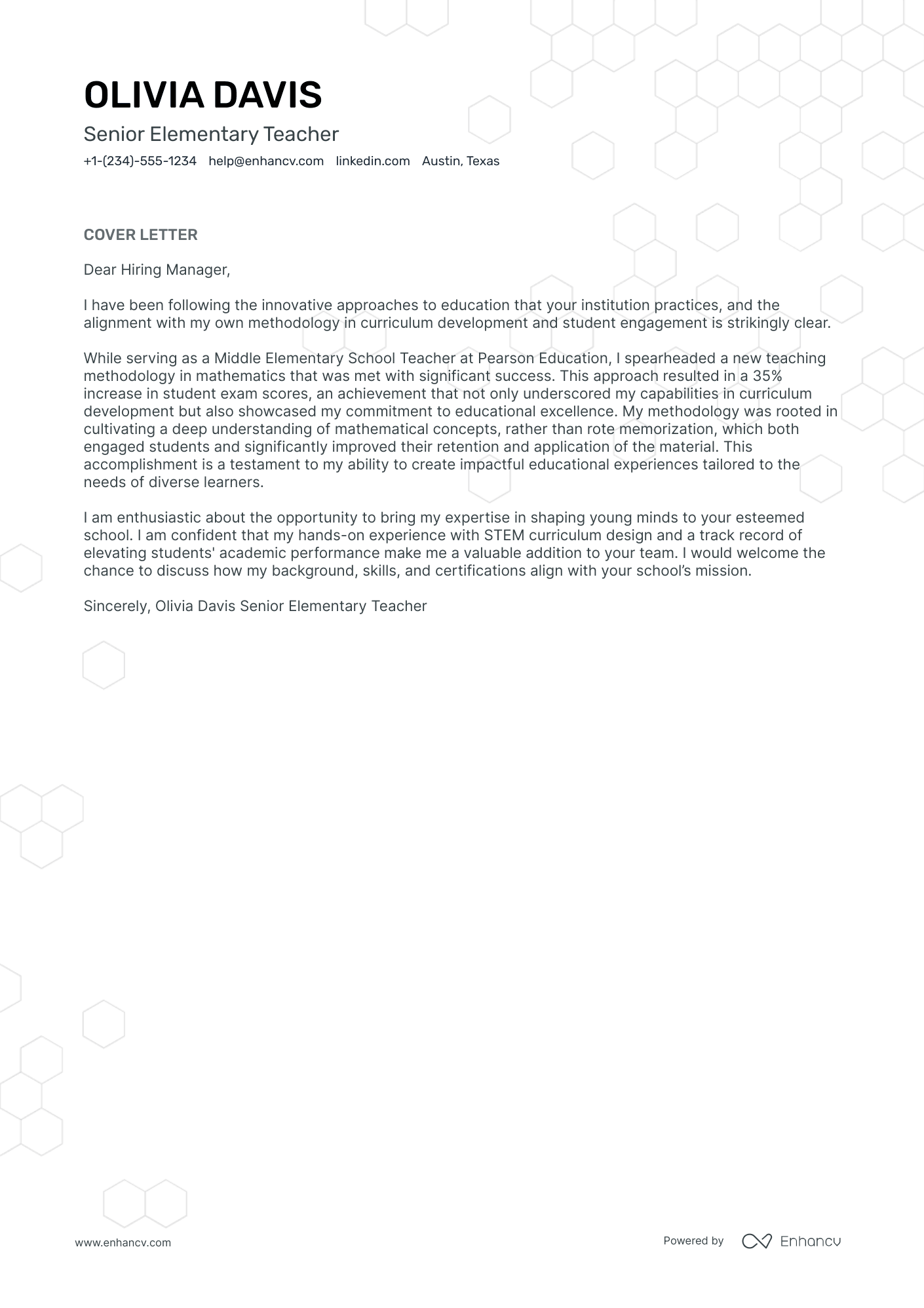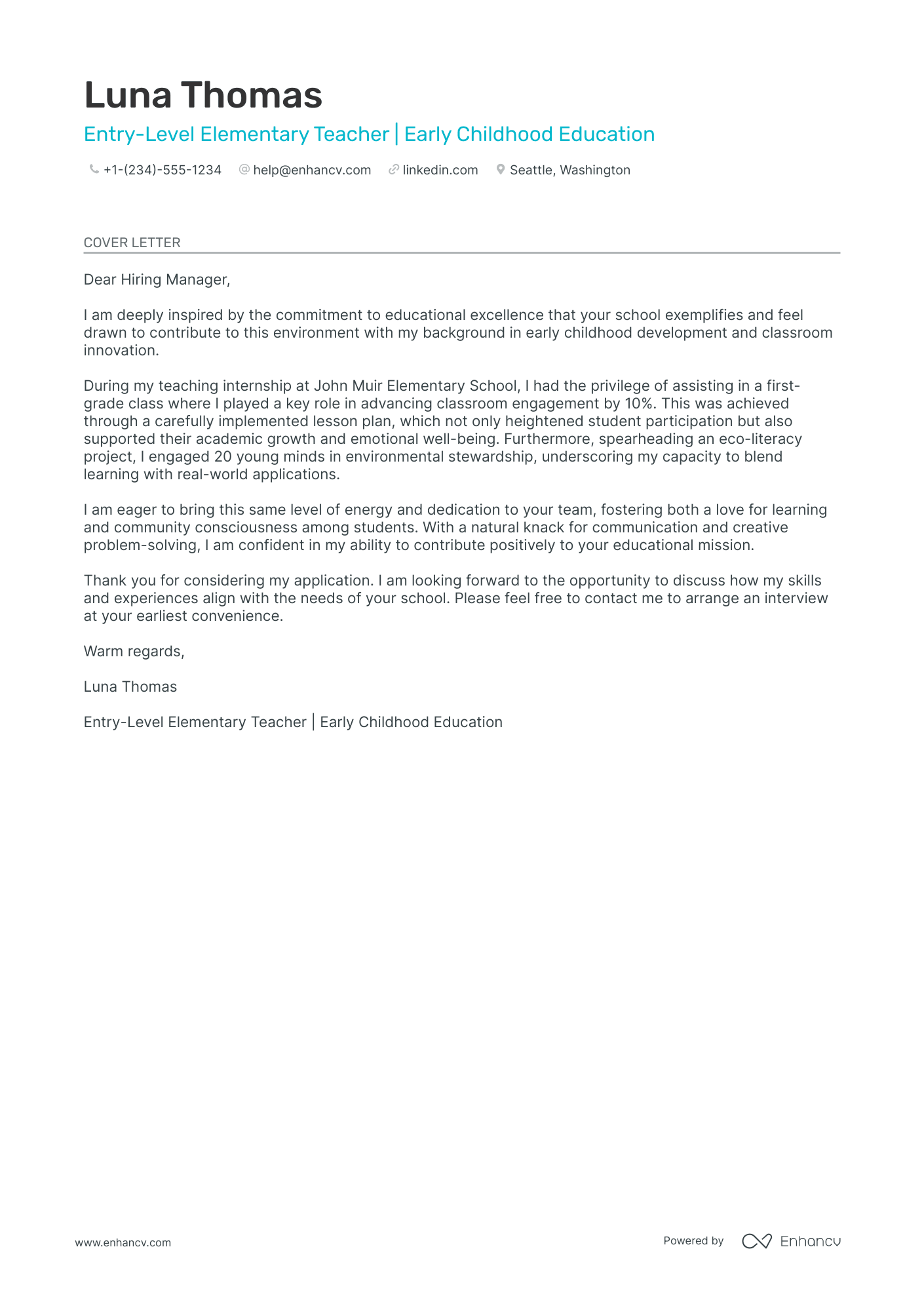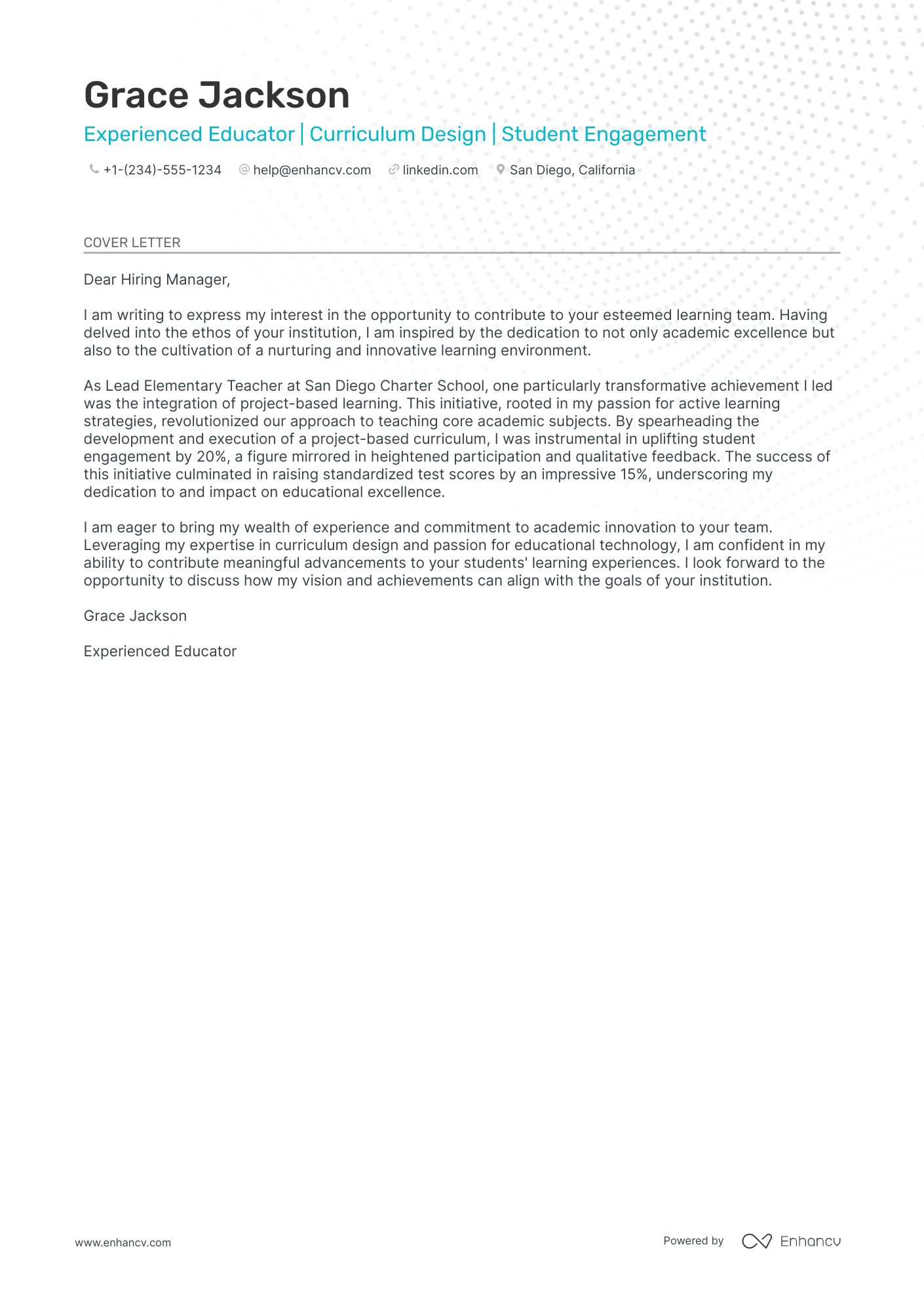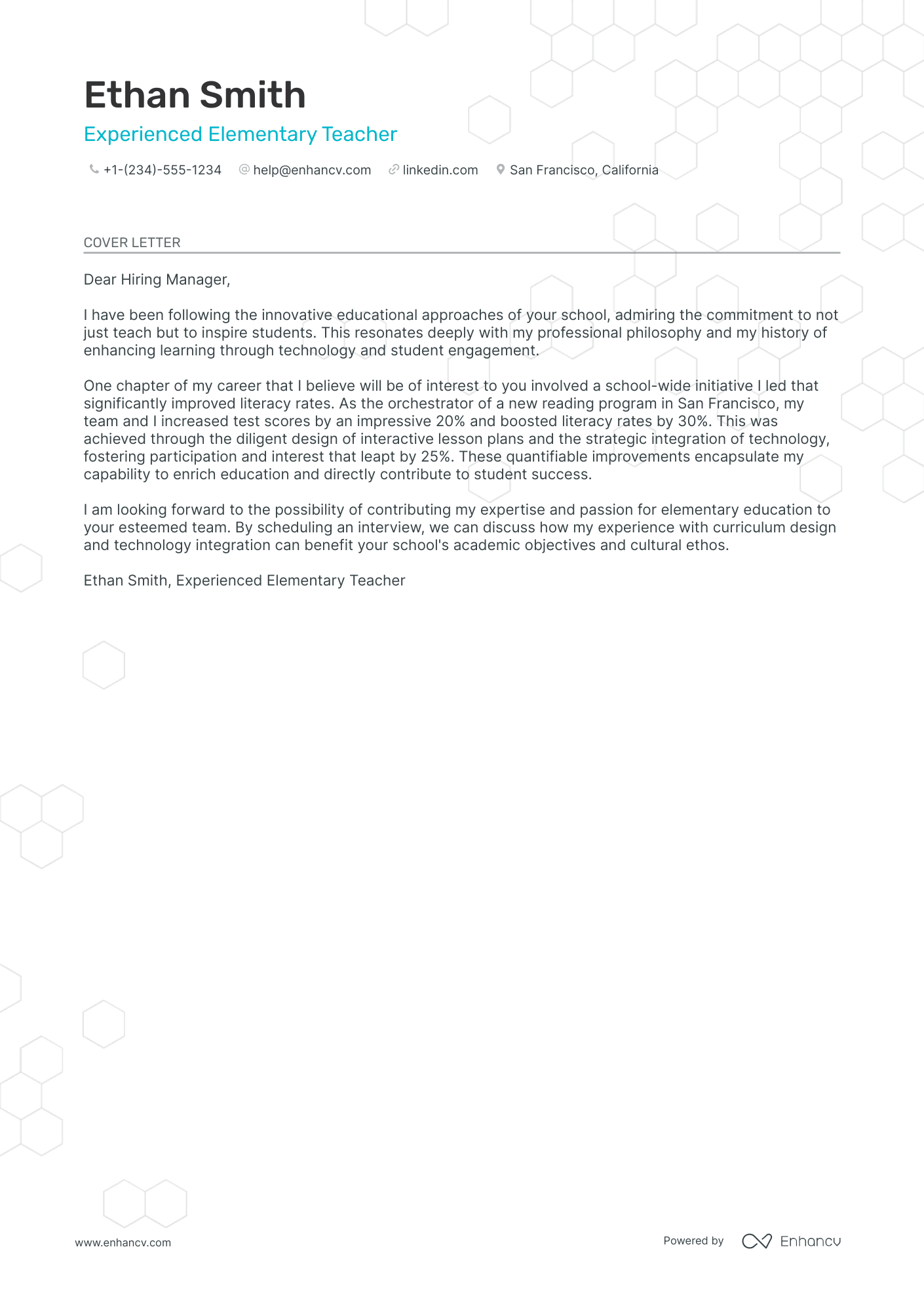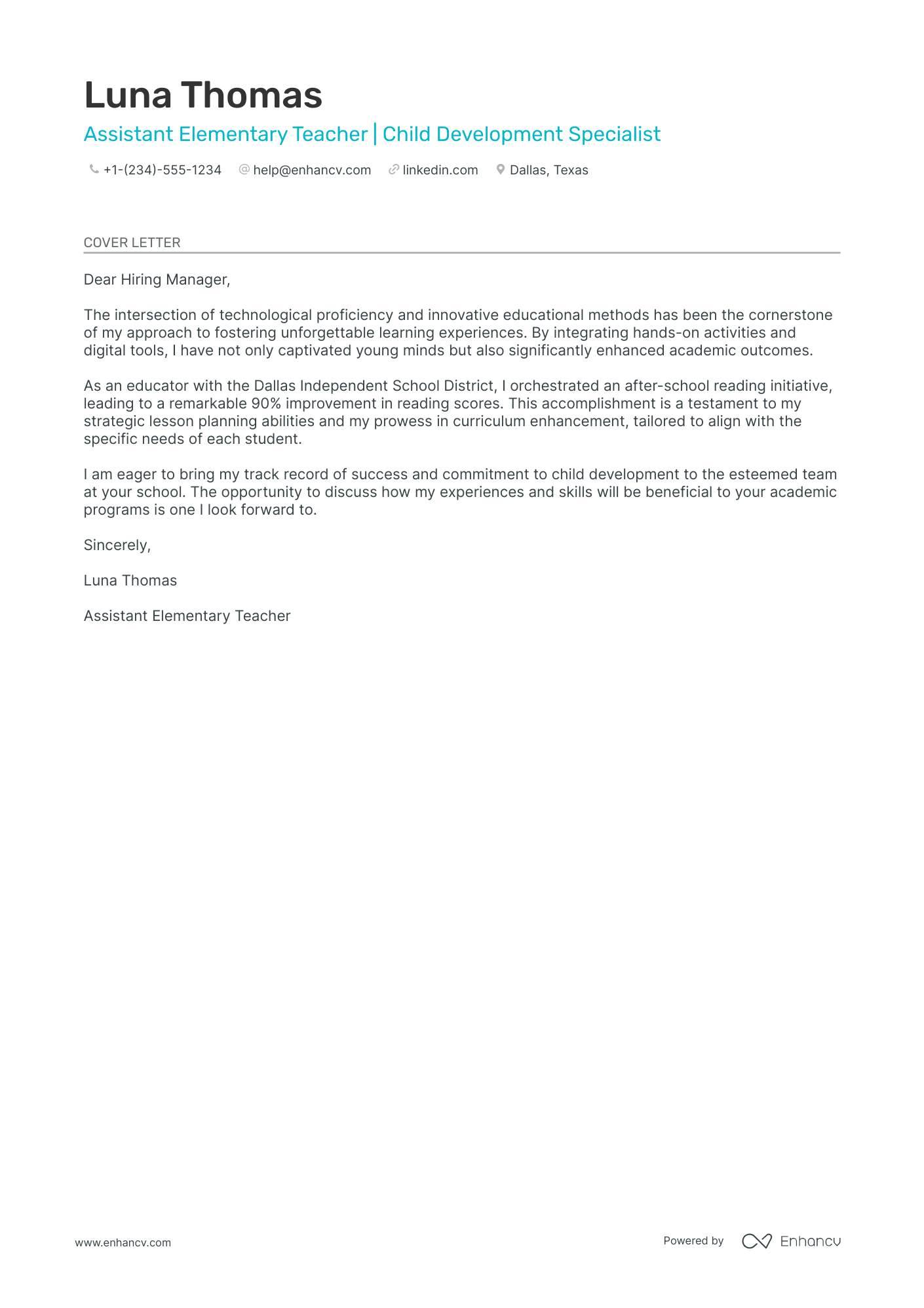Once you’ve crafted an organized, thorough resume, it’s time to write a compelling Elementary Teacher cover letter.
Whether you're new to teaching or an experienced educator, your cover letter is an opportunity to share how your personality, values, skills, and experiences make you an excellent candidate. However, choosing which skills and experiences to highlight without overwhelming your reader can be challenging.
This step-by-step guide, including tips and examples, will enable you to compose a captivating cover letter that:
- Reflects who you are as a teacher
- Emphasizes the qualities that make you an exceptional educator
- Stand out to the schools where you apply
If the elementary teacher isn't exactly the one you're looking for, we have a plethora of cover letter examples for jobs like this one:
- Elementary Teacher resume guide and example
- Professor cover letter example
- Summer School Teacher cover letter example
- Online Teacher cover letter example
- Early Childhood Teacher cover letter example
- High School Teacher cover letter example
- Special Education Teacher cover letter example
- Language Teacher cover letter example
- Graduate Teaching Assistant cover letter example
- School Counselor cover letter example
- Music Teacher cover letter example
Drop your resume here or choose a file.
PDF & DOCX only. Max 2MB file size.
Elementary teacher cover letter example
ISABELLE TODD
Tampa, FL
+1-(234)-555-1234
help@enhancv.com
- Alignment with School Values: The cover letter effectively communicates the candidate's alignment with the school's child-centric learning philosophy, which is essential for an elementary teacher role.
- Evidence of Achievements: Highlighting past accomplishments like leading a school-wide Self Study and advising a school newspaper demonstrates the candidate's ability to effectively contribute to school initiatives and improve student engagement and success.
- Commitment to Academic Excellence: By citing a specific achievement of a 98% student pass rate, the candidate showcases a proven track record of results driven by innovative teaching methods, which is attractive to educational institutions aiming for high academic standards.
How to format an elementary teacher cover letter
Formatting is essential when constructing a cover letter, especially in education. Creating organized and professional-looking materials is a required skill for Teachers. A well-formatted cover letter is an opportunity to demonstrate this skill, quickly making a positive first impression.
Cover letters shouldn’t exceed one page. The goal is to let readers know a bit about you without sharing every detail of your journey in education. Keep your writing focused and concise to avoid surpassing one page.
Grammar and editing are vital to maintaining a positive first impression. Be sure to use standard font and spacing. If you are unsure about formatting, APA style is typically used in education. Remember to proofread carefully before finishing.
Ensure your cover letter is focused and doesn’t ramble. It must include a beginning, middle, and end that flow to communicate a cohesive message.
Skip the hassle of writing a cover letter. Use our free cover letter generator and get it done in moments.
Sections to include in an elementary teacher cover letter:
- Header: Include your name, job title, and contact information (address, phone, professional website, etc.) Creativity is integral in elementary education. Don’t be afraid to get creative by using a little color or adding a headshot of yourself as long as you maintain a professional overall appearance.
- Salutation: Personalized salutations are best when possible.
- Introduction: A summary of your background and what makes you a great candidate.
- Body: Focus on the specific school you’re applying to.
- Conclusion: Thank the reader and invite requests for further information.
Key qualities recruiters search for in a candidate’s cover letter:
- Mastery of Basic Subjects: Elementary teachers often teach multiple subjects, from math and reading to science and social studies. Recruiters prioritize educators who have a strong grasp of these foundational subjects to ensure students receive a well-rounded education.
- Child-Centered Approach: Given the young age of their students, elementary teachers need to adopt a child-centered teaching approach. This means understanding the developmental stages of children and tailoring lessons to be engaging and age-appropriate.
- Experience with Early Literacy and Numeracy: The foundational years of literacy and numeracy are critical. Recruiters look for teachers who have specific experience and strategies in teaching reading, writing, and basic math to young learners.
- Skills in Handling Younger Students' Emotional Needs: Young children can have varied emotional needs. Elementary teachers with the ability to recognize, understand, and address these needs can create a more supportive classroom environment.
- Use of Creative and Play-Based Learning: At the elementary level, play-based and creative learning methods are highly effective. Recruiters prioritize teachers who can incorporate these methods into their lessons, making learning more enjoyable and memorable for students.
- Parent-Teacher Communication Skills: Especially at the elementary level, regular communication with parents is essential. Teachers who can effectively update and collaborate with parents about their child's progress and needs are highly valued in elementary settings.
How to write your elementary teacher cover letter salutation
A personalized cover letter salutation is always best. It sends a message to hiring administrators that you’ve researched the specific position and school you’re applying to.
Take the time to research who will review applicants. In schools, reviewing candidates may be the responsibility of HR, the superintendent, the principal, or the department head.
If the job posting doesn't state the recipient's name, contact HR to inquire who will review candidates. If you’re still unable to verify the recipient, addressing the letter to the school principal is appropriate.
How to write your elementary teacher cover letter intro
Your cover letter introduction should grab the reader's attention, making them want to learn more about you. Begin your introduction by sharing something the reader couldn’t know by simply reading your resume.
Consider using one of these ideas to hook your reader:
- Share why you decided to become a teacher
- Describe what motivates you as a teacher
- Explain how a non-teaching work experience has given you a unique perspective on teaching
- Describe your teaching philosophy and how you developed it
- Explain how a past achievement reflects on you as a teacher
- Share future goals you hope to accomplish in teaching.
Once you’ve hooked your reader, conclude your introduction with a thesis statement explaining how your teaching skills, philosophies, or experiences align with the school's.
Pro tip
To be specific about how a school’s values and goals align with your own, you must research the school. The following can be valuable sources of information and inspiration.
- Information directly from the job posting
- Keywords used to describe the ideal candidate
- Information shared about the school community
- School-wide specialization or focus (Arts, STEM, bilingual education, etc.)
- The school website
- The school motto
- The school’s mission statement
- An announcements page sharing new initiatives, accomplishments, or upcoming changes
- Specific information about the community they serve
This is an example of the wrong way to write an elementary teacher cover letter because it is completely focused on the applicant. The teacher lists much of the same information available on their resume including background, qualifications, and experience. Additionally, they end the intro by describing their expectations but make no attempt to demonstrate how they align with the specific school or position.
Here is an improved version of this teacher introduction:
In this version, the teacher hooks the reader by describing how their perspective has changed since their first day of teaching. They work in detail about their background, experiences, and values as they share the story. Finally, they conclude by drawing a connection between their desire for ongoing growth and the school's dedication to the ongoing education of teachers.
How to write your elementary teacher cover letter body
The goal of the cover letter body is to sell yourself as an exceptional elementary teacher candidate. Use the body section to expand upon your introduction by giving examples, elaborating on details, and sharing. additional relevant information.
Consider including some of these qualities commonly sought by schools hiring elementary school teachers.
- Organization
- Leadership
- Effective communication
- Planning engaging lessons and activities
- Setting and achieving goals
- Meeting established standards
- Positivity and enthusiasm
When deciding which qualities to include in the body, remember to select skills and values that exemplify why you’d make a great addition to their school community. Teaching philosophies and values can vary significantly among schools. Nevertheless, each school is looking for an applicant whose teaching philosophies and values align with their own.
Check out the following examples of selecting skills to highlight when applying to a school offering a specialized focus on STEAM (Science, Technology, Engineering, Arts, and Mathematics):
This version gives insight into the teacher's philosophies of classroom management and teaching and how they have been successful. These are not necessarily the skills that would appeal to a STEAM-focused school where creativity, problem-solving, and hands-on learning are highly valued.
The following example demonstrates how a shift in focus can improve the appeal to this particular school.
In the improved body paragraph, the teacher highlights their creativity and hands-on approach to learning. The philosophies in each example are not independent of one another. The same teacher could easily believe and utilize both approaches. However, by choosing the approach that would be most relevant to this particular school the teacher has demonstrated skills that will be highly valued by this school.
How to write an elementary teacher cover letter with no experience
First-time teachers may feel at a disadvantage writing a cover letter without experience to draw upon to describe their suitability for a teaching position. However, you can still write a compelling cover letter by drawing upon relevant experiences outside of teaching.
Follow these steps to write an Elementary Teacher cover letter without teaching experience.
- Don’t focus on your lack of experience. Instead, think creatively about how different experiences you’ve had to demonstrate abilities necessary for teaching.
- When considering alternative experiences, choose examples that are relevant to teaching. A few examples of relevant experiences could be leadership or management roles in past jobs, organizations, or school projects, childcare experience as a babysitter or camp counselor,
- community service projects demonstrating organizational and community support, or involvement in organizations such as the Scouts, Big Brothers/Big Sisters, or youth groups.
- Explain how the experience demonstrates a skill or quality relevant to teaching.
- Select experiences that demonstrate skills or qualities aligned with those sought by the school.
How to implement psychology and writing tools in your cover letter
Teaching children requires more than just the right qualifications. Great teachers also exhibit certain personality traits that enhance their success in the classroom.
Demonstrating these personality traits through the writing in your cover letter can effectively draw the attention of school administrators who understand the necessity of finding the right personality for the job.
Be Confident. Teachers are leaders in their classrooms. They must be competent, self-assured, and decisive. Therefore, your cover letter should avoid uncertain phrases like “I think” “I believe” “could” or “might.”
Tell a story. Elementary teachers must be engaging and captivate their student's attention. Telling an interesting and relevant story to captivate your reader's attention demonstrates this skill.
Be human. Elementary teachers must be kind and understanding toward their students. Sharing a time when you made a mistake or failed at something and learned from it demonstrates humility and empathy.
Your cover letter is a great place to let your personality shine through your writing. Telling someone you’re kind is much less effective than showing them through your actions. Following these best practices, you can achieve the same effect with your writing.
How to write your elementary teacher cover letter conclusion
The tone of your cover letter conclusion is what readers will remember best. Rather than ending the letter abruptly, leave readers excited about you by expressing your enthusiasm.
Include the following elements in your teacher cover letter conclusion.
- Express your excitement about finding a potential match.
- Convey gratitude for taking the time to review your application.
- Invite the reader to contact you with questions or to request information.
- Share your anticipation of further communication.
Elementary Teacher cover letter examples
By Experience
Senior Elementary Teacher
Entry-Level Elementary Teacher
By Role
Kindergarten Teacher
Elementary Art Teacher
Elementary Music Teacher
Pre-K Teacher
Assistant Elementary Teacher
Elementary Substitute Teacher
Key takeaways
Remember, these key points to ensure your elementary teacher cover letter gets noticed and gets you one step closer to the classroom.
- Use clear, professional formatting and editing to demonstrate the skills required of teachers.
- Share your “teacher personality” through your writing.
- Research the school to focus on skills and experiences relevant to them.
- Make a clear connection between your values and the school’s.
- Express your enthusiasm in the conclusion.


